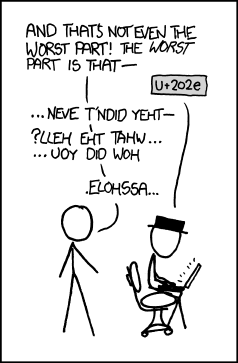א0 0א 0-א א-0
The issue is where you do this, and the implementation.
To get Hebrew-number behavior all the characters must be in right-to-left directionality. In HTML/CSS that is:
<p style="direction:rtl"> א0 0א 0-א א-0 </p>
In the Operating System, Hebrew and bi-directionality must be enabled.
The workarounds by suggesting the use of other characters as substitutes, defeats the purpose of Unicode. The aleph as a mathematical operator may look the same in some character sets, but is an entirely different character than the Hebrew aleph, both in context and how it will be parsed. For example, a Hebrew-native speaker/computer will not process it correctly if used in conjunction with a Hebrew word. Numbers and non-alpha characters are a problem when they are not themselves given the same directional encoding as the alpha characters. Thus, ironically, numbers themselves while seemingly should be independent of a character-set/directionality, take on whatever unicode directionality of the preceding letter. Thus in a Hebrew document - the numbers become 'Hebraicised' i.e. directionally like Hebrew. Whereas an English-Latin document, the Hebrew letters can be mixed up and messed up because of the lack of directionality attributed to the paragraph.



14At first glance I thought you were crazy. Turns out it's simply an artefact of how different language directions are used. Great question! – None – 2017-07-31T13:09:09.337
1It strongly depends on the software you are using. Those that put the 0 to the left ot the א switch to Right-To-Left, those that put the 0 to the right of the א instead, either don't support RTL or don't automatically switch based on inputted characters. – simlev – 2017-07-31T14:34:54.743
6For writing Hebrew text, this order makes sense. Otherwise it would be most annoying to type stuff like
ב-5 דקות(in 5 minutes). – ugoren – 2017-07-31T14:50:08.3201@ugoren: But I dare say that most of us who are using aleph are writing math, not Hebrew. Maybe there should be a math aleph (and other Hebrew chars that might be used in equations), and a Hebrew language one? – jamesqf – 2017-07-31T16:23:15.333
7@jamesqf: And there is one, see IllidanS4's post. – user1686 – 2017-07-31T18:32:39.877
28@jamesqf, Hebrew letters exist in Unicode for writing Hebrew. And I dare say there are more of us who write Hebrew (7 millions or so) than those who write about set cardinalities. – ugoren – 2017-07-31T20:30:14.230
@cmbuckley cough Vsauce cough – Jack – 2017-07-31T21:01:36.177
27
@ugoren by some counts there are 130k mathematicians, but in truth, mathematics is the universal language, so there's really ℵ₀.
– Nick T – 2017-07-31T22:34:02.370